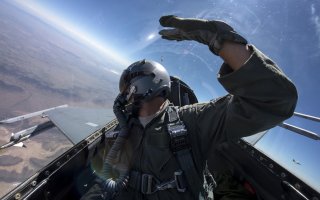How Do Fighter Pilots Pee While Flying?
The key is to anticipate times when you’ll have a few minutes of straight and level flight.
As a fighter pilot, one of the most common questions I get is: How do you go to the bathroom in an F-16 or F-35? Let me start off by describing the cockpit.
A cockpit in a modern fighter is an engineering masterpiece. An incredible amount of effort goes into allowing us to interface with the aircraft. In fact, as pilots, we don’t say we’re climbing into the jet; rather, we call it strapping the jet on our back, because it feels like you and the aircraft become one entity. All the buttons and controls surround your body, allowing you to quickly react to an adversary.
Data is displayed throughout our field-of-view starting in the helmet with true augmented reality, then extending to screens in front of us, and finally to an instrument console between our legs. We have an unprecedented amount of situational awareness, however, the tradeoff is there’s no room for a bathroom.
Now, typically in training, our flights are less than an hour and a half. As long as you don’t drink too much coffee before a flight, it’s generally not a problem. However, in combat, I’ve flown missions as long as 8 hours; crossing the Atlantic, I was airborne for over 10 hours. For these missions, I used what we as pilots affectionately call, piddle-packs.
Piddle-packs are the ultimate long road trip solution. They are specially shaped bags with absorbent beads in them. If we have to relieve ourselves, we’ll unzip the flight suit—which is designed to unzip from the top as well as the bottom—unroll the piddle pack, and then pee into it. Once done, we’ll seal the top, while the absorbent beads turn it into a gel that won’t leak during hard maneuvering.
While the concept is simple, it takes time to become proficient at it. Imagine driving a car while unwrapping a bag and peeing into it while staying in your lane and avoiding traffic. Now take that and amplify it in a 3-dimensional world while flying just under the speed of sound with an enemy that’s potentially trying to shoot you down.
The key is to anticipate times when you’ll have a few minutes of straight and level flight. While in Afghanistan, I would typically use the time it took to travel to the tanker. This allowed me to finish up before I got to the tanker, refuel, and then gather situational awareness while I was returning to the fight.
Because it’s a task-saturating event and difficult to maintain formation or answer radio calls, we’ll use the brevity term “racehorse” to let our wingmen know we’re busy for the next few minutes. This allows them to pick up the slack and minimize extraneous talking until we’re done.
Since I’ve been in the Air Force, a number of devices have been developed to make the process easier—particularly for women. I’ve never flown with any of them, but they usually involve an undergarment with a jockstrap that is attached to a vacuum. When the pilot needs to pee, they turn on the vacuum and relieve themselves without having to unzip. While the process is simpler, for me, the upfront preparation, along with the added weight and complexity of a vacuum, have made the cost greater than the benefit.
As for your follow-up question, how do you go number 2? The answer is, you don’t.
Justin Lee is an active duty U.S. Air Force F-35 Joint Strike Fighter pilot. Lee has earned four Air Medals over the span of more than 400 hours of combat flight time throughout his eight+ years at the stick of the F-16 Fighting Falcon and F-35, and now he’s bringing his unique insight to the audio world with his incredible new podcast, “The Professionals Playbook.”
This article first appeared on Sandboxx News.
Image: U.S. Air Force photo by Master Sgt. Jeffrey Allen / Released

